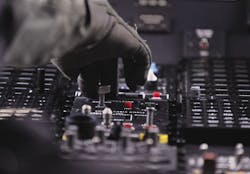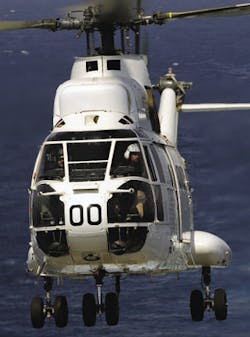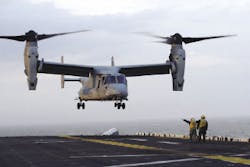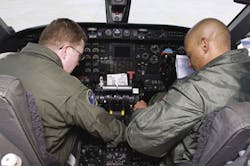U.S. Navy and Marine Corps manned and unmanned aircraft benefit from increasingly robust, flexible, and advanced electronics.
By Courtney E. Howard
U.S. Navy and Marine Corps officials share a singular goal: to infuse new and existing aircraft with advanced avionics technology. Today’s avionics advancements, being employed in manned and unmanned aircraft, provide a competitive advantage and increased potential for mission success and warfighter safety.
Aerospace and defense systems integrators and systems architects face myriad challenges when upgrading current fleets and outfitting new fixed-wing aircraft and helicopters, however. “All airborne platforms are sensitive to size, weight, and power [SWaP],” says Curtis Reichenfeld, P.E., chief technical officer at Curtiss-Wright Controls Electronic Systems in Santa Clarita, Calif. “A system architect must always balance system performance, technology maturity, risk, and reliability in avionic designs and their impacts to size, weight, power, and cost [SWaP-C].”
Compact, robust, cost-effective avionics are gaining momentum. “We’ve already seen changes, such as lighter, more-efficient, low-voltage LCDs [liquid crystal displays] replacing large, heavy CRT [cathode ray tube] displays which required high voltage to operate,” recognizes Mike Henderson, director of military & aerospace products at TDI Power in Hackettstown, N.J. “Gone are the days of donut-shaped power supplies with holes in the middle for the neck of a CRT to fit through because that was the only room available; but, packaging remains a major challenge when you are in a very tight location like a cockpit.”
Compute density
Avionics systems architects and systems integrators endeavor to deliver high compute density, outfitting aircraft with increasingly robust, powerful, and functional electronics in a reduced footprint. Flexible, multi-role systems are often prized above proprietary, single-use systems in such SWaP-restricted environments and applications.
“Some avionics applications place a high value on open architectures, which provide scalability and modularity,” Reichenfeld describes. “Some customers feel technology readiness level [TRL] is more important, knowing where the components have been qualified and deployed in similar applications to reduce risk. We always try to avoid any proprietary or single source technologies which can create future issues in deployed systems.” As a result, Curtiss-Wright offers a selection of commercial off-the-shelf (COTS) building blocks and intellectual property for off-the-shelf systems and custom avionics solutions.
“As compute platforms and digital interfaces get more capable and more dense, a significant consideration for application designers is having available solutions that span many different configuration options for on platform, test, and simulation applications,” says Ben Daniel, avionics business leader at GE Intelligent Platforms in Charlottesville, Va.
As avionic electronics continue to become more dense and more powerful, we are focused on putting more capability into smaller packages, Daniel adds. “It obviously brings up SWaP considerations ranging from the straightforward ‘more communication channels on a mezzanine board’ so that slots are freed up to put more functions in a box, to GE Research Center’s developments with leading-edge thermal management techniques necessary for truly high-density assemblies.”
“While ruggedness and reliability are a given as needs for embedded applications, we find that available supplier factory support across the many configurations, operating environments, and case-specific requirements is key to usability in integration and field support,” Daniel explains. He and his colleagues at GE support the development, simulation, test, and embedded phases of avionics programs across military and civilian aircraft, including mission systems ranging from electronic warfare, sub hunting, maritime surveillance, weapons computers, navigation computers, and information display subsystems in rotary and fixed-wing aircraft.
Helicopter requirements
U.S. Navy and Marine Corps aircraft have some unique requirements to consider in avionics systems, Reichenfeld says. “Rotorcraft missions require operation in low-visibility situations, such as whiteout and brownout conditions, requiring the avionics to provide better situational awareness. Urban operations also have unique challenges, such as avoiding cables and wires at low altitudes.”
Situational awareness is of paramount importance to today’s pilots and crew. As a result, aircraft are being outfitted with myriad sensors and other imaging devices. Naval Surface Warfare Center officials selected Lockheed Martin in Bethesda, Md., to provide support, spare units, and parts for the Target Sight System (TSS) on U.S. Marine Corps AH-1Z Cobra attack helicopters.
The TSS delivers imagery via a highly stabilized sensor suite tailored specifically to the AH-1Z attack helicopter. The AN/AAQ-30 multi-sensor, electro-optical/infrared (EO/IR) fire control system incorporates a large-aperture, midwave, forward-looking infrared (FLIR) sensor with advanced image processing, a color TV camera, a laser designator/rangefinder with eye-safe mode, and an on-gimbal inertial measurement unit into a stabilized turret.
Lockheed Martin won two contracts totaling $30.6 million to support the AH-1Z fleet. Production, which takes place at facilities in Ocala and Orlando, Fla., is expected to continue through 2018.
“TSS provides positive combat identification at safe standoff ranges,” explains Joseph Butera, senior program manager of airborne systems in Lockheed Martin’s Missiles and Fire Control business. “The system allows AH-1Z aviators to confidently engage the threat and return safely to base.”
The AH-1Z, produced by Bell Helicopter Textron Inc. in Hurst, Texas, is part of the U.S. Marine Corps H-1 upgrade program, being heralded for bringing the organization into “the digital interoperability age.” The program replaces aging AH-1W and UH-1N fleets with AH-1Z and UH-1Y helicopters offering improvements in commonality, reliability, and maintainability.
Northrop Grumman Corp.’s Integrated Avionics System is credited for its role in preparing the AH-1Z helicopter for deployment. The AH-1Z and UH-1Y helicopters work together as a team aboard the USS Makin Island with the 11th Marine Expeditionary Unit (MEU). “The dual deployment takes advantage of the 84 percent commonality of parts between the UH-1Y and AH-1Z helicopters in the H-1 upgrade program, which reduces life cycle and training costs and decreases the logistics footprint for both aircraft,” explains a Northrop Grumman spokesperson. “The upgraded helicopters also have 100 percent software commonality through Northrop Grumman’s Integrated Avionics System [IAS] and the same operational flight program.”
The IAS powers the helicopter glass cockpits, improving the air crew’s situational awareness and weapons accuracy by providing access to critical mission data on four displays. The IAS boasts two mission computers with an open, modular architecture that enables the rapid insertion of new technologies and systems upgrades.
“The Integrated Avionics System is dramatically improving the situational awareness abilities of these H-1 aircraft in challenging environments,” says Ike Song, vice president of situational awareness systems at Northrop Grumman’s Navigation Systems Division.
Engineers have installed and tested a smaller version of the IAS in the back of a retrofitted UH-1N helicopter transferred from the U.S. Marine Corps and serving as an avionics test bed for future rotary wing hardware and software developments. Northrop Grumman’s Digital Avionics Suite technology aided in the first flight of the Test Bed for Rapid Warfighter Response and Experimentation, called T-Rex and operated by the U.S. Naval Aviation Center for Rotorcraft Advancement (NACRA) in Patuxent River, Md. T-Rex is the only rotary wing technology test bed currently flown by the Navy, according to a Northrop Grumman representative.
The Digital Avionics Suite includes an upgradeable mission computer, two multifunction displays to deliver critical mission data to flight test engineers, and an LN-251 embedded global positioning system/fiber-optic inertial navigation system for precise positioning.
“T-Rex allowed us to quickly and easily demonstrate enhanced combat capability concepts for a warfighting platform,” says Lt. Col. John Selby, the AH-1W/UH-1N team lead of the Marine Corps Light Attack Helicopter Program.
“The addition of the Digital Avionics Suite to NACRA’s T-Rex shortens the analysis and test time for improvement of avionics systems,” Song adds.
Enabling VTOL and STOL
The V-22 Osprey, produced under a strategic alliance between Bell Helicopter in Fort Worth, Texas, and The Boeing Co. in Chicago, is a unique aircraft incorporating novel avionics to deliver the combined functionality of a conventional helicopter and that of a long-range, high-speed turboprop. The military, multimission tiltrotor aircraft, designed to meet the needs of all the U.S. armed forces, boasts vertical takeoff and landing (VTOL) and short takeoff and landing (STOL) capabilities. To date, the Osprey has been deployed in combat and rescue operations over Iraq, Afghanistan, and Libya.
The Ducommun LaBarge Technologies (DLT) business unit of Ducommun Inc. in Carson, Calif., won a $14 million Bell Helicopter contract to produce electronic assemblies and wiring harnesses for the V-22 Osprey Aircraft Program. DLT’s work on the contract will be performed at the company’s Huntsville, Ark., and Joplin, Mo., operations through the fall of 2013.
“The Bell-Boeing V-22 Osprey combines the speed of a plane and the hovering ability of a helicopter; it is a true multitask aircraft,” says Anthony J. Reardon, president and chief executive officer at Ducommun. “Whether the job is transporting troops, delivering cargo, or flying Special Forces operations, the V-22 brings more capabilities to the mission than any other aircraft on the market.”
U.S. Navy avionics experts are looking to the Bell-Boeing Joint Project Office in Amarillo, Texas, to design a new, integrated avionics processor into the U.S. Marine Corps MV-22 and U.S. Air Force CV-22 tiltrotor aircraft. Bell-Boeing won a $42.1 million contract from the Naval Air Systems Command at Patuxent River Naval Air Station, Md., to develop, qualify, test, and integrate a new avionics processor for the Marine Corps and Air Force versions of the V-22 Osprey tiltrotor.
The new avionics processor for the MV-22 will resolve electronics obsolescence issues, add new network capabilities, increase data throughput for the Osprey’s legacy Mil-STD-1553 avionics data bus, and re-host mission computer capabilities to enhance avionics and operations readiness for the V-22 program. Bell-Boeing engineers will do the work in Ridley Park, Pa., and Fort Worth, Texas, and should be finished by October 2014.
Hardware and software upgrades in the V-22 program must be flexible and forgiving, enabling rapid design modifications with minimal disruption and cost. Boeing officials in Chicago chose to upgrade the U.S. Navy’s V-22 tiltrotor aircraft with remote interface units (RIUs) from Smiths Aerospace in Grand Rapids, Mich. The standardized unit’s ability to interface with various aircraft sensors and to communicate with different computing resources supports the industry’s transition to integrated modular avionics (IMA) architectures, according to a spokesperson.
Smiths’s RIU, located in the engine nacelle, wing, and avionics bay on the V-22, digitizes voltage, current, frequency, and temperature signals and delivers the information to aircraft systems over the aircraft’s MIL-STD-1553 databus and communication network.
Carrier-based considerations
Reliable operation under very adverse environmental conditions is a critical aspect of avionics, explains Henderson. “Aircraft may be exposed to salt spray or pressure washing while on the ground or on the flight deck of a carrier, and any residual liquid will quickly freeze at altitude. If the electronics are not sufficiently sealed against these conditions, the systems will not function.”
A sealed electronics enclosure can quickly become a thermal-management nightmare, however, without a novel electronics cooling solution providing sufficient heat dissipation. Many TDI Power designs employ a thermal-management system with air blowing through an air plenum (fin stock) that runs through the center of the power supply.
“Heat is dissipated from electrical components in sealed compartments around the airflow and down through the plenum, creating a ‘wind tunnel’ effect for cooling without allowing any potentially dangerous contaminants to come in direct contact with sensitive electrical parts,” Henderson affirms.
Sensitivity is a major concern, and often not an option in various aerospace and defense systems designs. “In carrier-based operations, avionics must operate in high-radiation environments due to the shipboard radar systems,” says Reichenfeld. The avionics also need to be ruggedized for severe shock and vibration environments due to catapult launch and carrier landings.”
Systems interoperability is another major challenge when dealing with aircraft that are launched from aircraft carriers, Henderson says. “You must be able to interface with shipboard power, which typically is 440 volts AC/60 hertz/3 Phase as specified by MIL-STD-1399, but also work with airborne power as specified by MIL-STD-704, which may be 28 volts DC, 270 volts DC, or 115 volts AC/400 hertz.” TDI Power supplies power conversion equipment that resides not only on the deck of carriers, but also inside the aircraft launched from the ship. “All must play together seamlessly,” he says.
“The SWaP goals for advanced fighters and UAVs become more challenging with each new platform, and designers of power supplies must continue to be innovative so as to provide sufficient thermal management, component derating, and so on for reliable operation under very adverse conditions,” Henderson adds.
For single-engine aircraft, either a fighter jet or a UAV, a fast-responding, high-power emergency system is critical for control of newer, “more electric” aircraft, Henderson adds. TDI Power engineers were contracted to design and produce a 7.5 kilovolt-ampere, high-power DC/AC inverter that was part of an aircraft’s emergency power system. They devised an inverter that receives a DC input from either an auxiliary power unit (APU) or a battery, and converts it to regulated 115-volt AC/400-hertz power needed for emergency flight-control power.
C-130 commonality
Interoperability was a central concern for U.S. Air Force officials, as they sought a technology partner to upgrade the C-130J Super Hercules aircraft. Lockheed Martin won $167 million to develop the Block 8.1 enhancement, offering software and hardware capability expansion for all U.S. government C-130Js and those of operator countries that select the upgrade.
The new Block 8.1 configuration includes updated Identification Friend or Foe (IFF) capabilities, TEMPEST compliance, Automatic Dependent Surveillance-Broadcast (ADS-B), additional covert lighting, an enhanced inter-communication system, enhanced approach and landing systems, enhanced diagnostics, and a communications, navigation, surveillance/air traffic management data link.
“The C-130 has constantly changed and adapted to ensure it is always relevant and meeting the latest operational requirements,” says Lorraine Martin, Lockheed Martin vice president for C-130 programs in Marietta, Ga. “The Block Upgrade Program ensures interoperability across the worldwide C-130J fleet. This sophisticated degree of commonality across C-130J types and variants is one reason the proven Hercules is in such high demand.”
The Block 6.0 configuration is currently flying on the C-130J fleet; the Block 7.0 configuration is undergoing flight trials. C-130J aircraft are in production for the U.S. Air Force and Marine Corps, as well as for Iraq, Israel, Republic of Korea, Kuwait, Oman, and Tunisia. Australia, Canada, Denmark, India, Italy, Norway, Qatar, the United Kingdom, and the U.S. Coast Guard also fly C-130Js.
The U.S. Air Force C-130J also takes advantage of a Lockheed Martin-built intelligence, surveillance and reconnaissance (ISR) system within a palletized shelter that supports the collection of signals intelligence. Lockheed Martin’s Dragon Shield flexible roll-on/roll-off mission suite sports a modular, plug-and-play architecture, to support multiple missions (airlift and ISR) and fast, cost-effective introduction of new capabilities.
The Senior Scout suite of ISR equipment, built into a trailer-like container able to be rolled on and off C-130 aircraft, enables the use of C-130s for tactical signals intelligence and reconnaissance, such as exploiting, geo-locating, and reporting communications intelligence and signals of interest to air and ground component commanders.
Boeing Defense, Space & Security, a unit of The Boeing Company in St. Louis, is under contract with the U.S. Air Force to deliver C-130 Avionics Modernization Program (AMP) kits. C-130 AMP improvements include an integrated, digital glass cockpit compatible with night-vision goggles and new digital avionics for increased situational awareness, enhanced safety, and greater avionics commonality among the C-130 fleet.
F/A-18 functionality
Boeing Defense, Space & Security also won a $135 million contract from the U.S. Navy for engineering and manufacturing development of the F/A-18E/F Super Hornet Infrared Search and Track (IRST) sensor system. The F/A-18E/F IRST passive, long-range sensor searches out and detects infrared emissions, simultaneously tracks multiple targets, provides air-to-air targeting capability, and detects advanced threats, including those equipped with radar-jamming technology.
The IRST system is scheduled to achieve Initial Operating Capability in 2016. Boeing officials selected Lockheed Martin to produce the IRST sensor; GE Aviation, headquartered in Evendale, Ohio, to supply the fuel tank assembly that will contain the sensor; and Meggitt Defense Systems Inc. in Irvine, Calif., to deliver the unit’s cooling subassembly.
“IRST is a game-changer for air-to-air combat, providing a ‘first to see, first to strike’ capability,” explains Paul Hey, IRST senior program manager in Lockheed Martin’s Missiles and Fire Control business. “IRST works with the aircraft’s radar to enhance the overall weapon system performance—even in a jamming environment—allowing the warfighter to engage threats with a high probability of success.”
Boeing officials also selected Honeywell Aerospace in Clearwater, Fla., to supply ring laser gyros for U.S. Navy F/A-18E/F jet fighter-bombers and EA-18G electronic warfare aircraft. Boeing won a $10.6 million contract from the U.S. Naval Air Systems Command at Patuxent River Naval Air Station, Md., for work on the Navy F/A-18. Honeywell Aerospace engineers are providing 714 Honeywell model GG1320 digital, ring laser gyros. The self-contained inertial measurement system includes a three-axis inertial sensor containing three digital gyros and three accelerometers. The ring laser gyro weighs less than six pounds, occupies less than 90 cubic inches, and consumes less than eight watts of power. Work on the contracts is being done in Clearwater, Fla., and St. Louis, and should be finished by April 2013.
Boeing Defense, Space & Security officials selected next-generation, GH-series electronic standby instrument systems from L-3 Avionics Systems, a subsidiary of L-3 Communications in Le Bourget, France, as standard equipment on international variants of the F-15 and F/A-18 Super Hornet aircraft. The F/A-18 will be fitted with one RSD and one GH-4000 Reference Standby Display Repeater (RSDR), while new F-15 aircraft will carry two GH-4200 Reference Standby Display (RSD) instruments.
The GH-4200 RSD and GH-4000 RSDR, built for military applications and qualified to military standards, are each designed with an integrated air-data sensor card and direct pitotstatic connections. The systems provide attitude, altitude, and airspeed information in a layout that matches the aircraft’s primary systems, as well as optional interfaces for heading, slip/skid, vertical speed, and navigation data. Deliveries are slated to begin July 2012.
The contract award “expands the presence of [L-3] next-generation, solid-state equipment into the tactical aircraft market,” says Larry Riddle, vice president of business development for L-3 Avionics Systems. “With our ruggedized design and precise software, the GH-series is a critical component of these high-performance platforms.”
Unmanned uniqueness
U.S. Navy and Marine Corps missions and warfighters rely on the capabilities of unmanned aerial vehicles (UAVs) and their robust, yet compact avionics. Small size might lend to some avionics vulnerabilities, however.
“Higher-altitude UAVs are becoming more sensitive to radiation that cause single-event upset/latch up due to smaller and smaller feature sizes in available electronics,” cautions Curtiss-Wright’s Reichenfeld. “Special considerations are given to error detection, correction, or recovery. Autonomous or remotely piloted vehicles will soon be required to possess a sense-and-avoid capability with due regard. This capability will need to be certified by the local aviation authorities. Even in military avionics systems, safety-critical avionics must be ‘certifiable’ for DO-178B/DO-254 for future operations in the National Air Space, even though these aircraft may not be ‘certified’ by the FAA.”
More autonomy from avionics will benefit the manned and unmanned systems, Reichenfeld continues. “For manned systems, this autonomy offers pilot relief during refueling and lowers pilot training costs. For unmanned systems, this capability is essential to safely enhance range and persistent operations.”
High-altitude, long-distance UAVs are also contributing to increased security concerns. “Another trend in avionics is higher levels of encryption and requirements for multilevel security in communications and data storage,” Reichenfeld notes. “Future systems will require more reliable and secure communications and datalinks which are resistant to hacking and jamming.
“The ISR and attack roles of these systems will require multi-spectral sensing, enhanced radars, 3D visualization, and advanced target recognition, tracking, and targeting abilities,” Reichenfeld adds. “Self protection against future threats and cooperative roles in electronic warfare and electronic attack are necessary future capabilities. All of the above lead to a more system-of-systems [SoS] approach for networked battlefield operations.”
The technologies most important in avionics designs to meet future performance requirements are higher speed data buses, higher processing requirements for sensor fusion and autonomy, virtualization, and separation hardware/software for multiple and legacy operating systems, Reichenfeld reveals.
UAV autonomy
Engineers at Lockheed Martin in Bethesda, Md., and Kaman Aerospace in Bloomfield, Conn., transformed Kaman’s K-MAX power-lift manned helicopter into an unmanned aerial system (UAS) capable of autonomous or remote-controlled cargo delivery. The Marine Corps has deployed the K-MAX UAV from Lockheed Martin and Kaman to Afghanistan under the U.S. Navy’s Cargo Unmanned Aircraft Systems program.
Kaman personnel designed the K-MAX heavy-lift helicopter, and Lockheed Martin engineers designed the helicopter’s mission management and control systems for exceptional flight autonomy in remote environments and over long distances.
“We are committed to providing the Marine Corps with the life-saving unmanned capability of our proven airframe, reducing the risk to our forces by taking the cargo resupply mission from the ground to the air,” explains Sal Bordonaro, division president at Kaman Helicopters.
A Commander Operational Test and Evaluation Force report has confirmed that the unmanned K-MAX exceeded the Navy and Marines requirement to deliver 6,000 pounds of cargo per day.
“K-MAX has the capability to quickly deliver cargo, thus getting troops off the roads and allowing them to focus on other missions,” says Rear Admiral Bill Shannon, Program Executive Officer for Unmanned Aviation and Strike Weapons.
In other UAV news, Northrop Grumman engineers increased the pace and productivity of the X-47B flight test program following the UAV’s first flight in Nov. 2011. The tailless, autonomous aircraft, called Air Vehicle 2 (AV-2), is the second air vehicle developed under the Navy’s Unmanned Combat Air System Carrier Demonstration (UCAS-D) program. Avionics hardware and software onboard enable the computer-controlled, strike-fighter-sized X-47B unmanned aircraft to take off, fly a preprogrammed mission, and return to base in response to a mission operator’s mouse clicks.
Northrop Grumman’s UCAS-D joint industry team includes GKN Aerospace in the U.K.; Lockheed Martin; Pratt & Whitney in East Hartford, Conn.; Eaton in Cleveland, Ohio; General Electric; Hamilton Sundstrand in Windsor Locks, Conn.; Dell in Round Rock, Texas; Honeywell in Morristown, N.J.; Goodrich in Charlotte, N.C.; Moog in East Aurora, N.Y.; Wind River in Alameda, Calif.; Parker Aerospace in Irvine, Calif.; and Rockwell Collins in Cedar Rapids, Iowa.
The X-47B aircraft is transitioning to Naval Air Station Patuxent River, Md., for shore-based carrier suitability testing, scheduled to begin in early 2012. Staff will test the X-47B’s ability to conduct precision approaches to the carrier and to perform arrested landings and “roll-out” catapult launches at land-based test facilities. Its precision navigation computers and guidance, navigation, and control software—designed to enable the X-47B to make precision landings on a moving carrier deck—will also undergo flight testing.
More Military & Aerospace Electronics Current Issue Articles
More Military & Aerospace Electronics Archives Issue Articles







